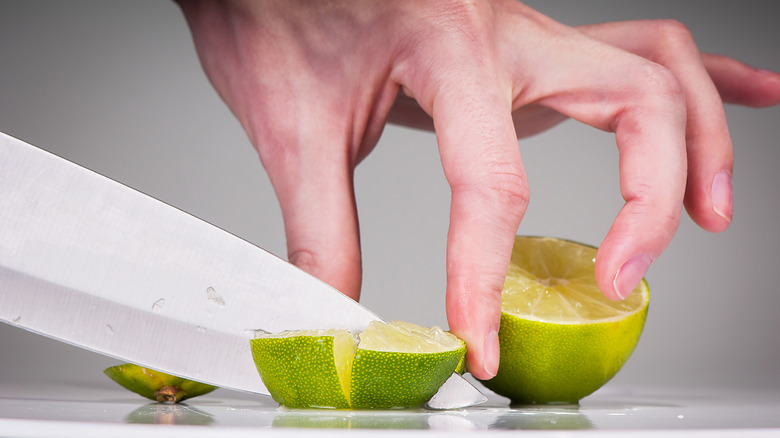When Making Margaritas This Summer, Beware Sunshine And Limes Don't Always Mix
The sun isn't the only thing that can give you a burn this summer. If you're a fan of the sweet and salty zing of a margarita, you'll want to be mindful that lime juice may cause some equally unpleasant burns if you're spending time outside in the sun (via Healthline).
With antioxidant properties and a healthy dose of vitamin C, limes can help stave off infection, boost immunity, and increase bone health, amongst other numerous benefits, reports WebMD. However, when it comes to the health of our skin, limes and sunlight don't always play nice with one another. According to Healthline, when lime juice comes in direct contact with our skin, the sun's rays create a chemical reaction with the furocoumarin contained in citrus fruits — leading to what's known as margarita burn, or phytophotodermatitis. Board-certified dermatologist Dr. Keira Barr further explains, telling Healthline, "This chemical can become activated by UVA rays. The furocoumarin is absorbed into the cells of the top layer of the skin, your epidermis, resulting in burning, redness, and blisters."
How to prevent margarita burns
If you've gone swimming or worked up a sweat while outside, the moisture on your skin's surface may worsen the severity of margarita burns, says Healthline. Able to cause second or third-degree burns, the damage left behind can be long-lasting. In mild cases, individuals may not be aware of any symptoms at all. For others, a rash generally emerges within 24 hours after lime juice has made contact with the skin. Swelling and painful blisters may then occur at the site within the following days. Eventually, dark patches or streaks may take the place of the blisters and can remain for several weeks or longer.
Experts at Shape emphasize that there is likely no danger of phytophotodermatitis from simply sipping on a margarita — phew! Rather, it has to do with the amount of lime juice our skin comes in contact with in addition to how much time we've spent in the sun. In other words, an accidental drip or two is not likely to do any harm. To err on the side of caution this summer, experts suggest promptly washing your hands with soap and water after exposure to lime juice and wearing protective clothing while outdoors, as most cases of phytophotodermatitis tend to show up on the arms, legs, and hands.
If you suspect you may be experiencing symptoms of phytophotodermatitis, Healthline suggests seeking treatment from your doctor to help safeguard against additional infection.


